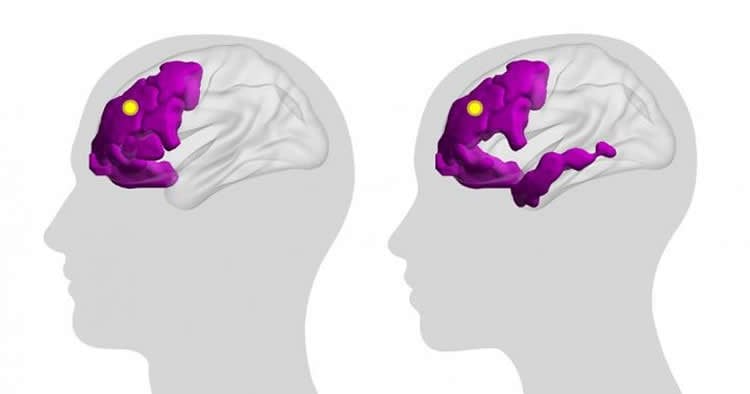Summary: Study explores how large scale patterns of brain activity can vary between cognitive systems, and across people.
Source: University at Buffalo
Like instruments in an orchestra, different parts of the human brain work together to help us perform the functions of daily life, ranging from breathing and sleeping to reading, walking and learning.
But which areas of the brain work in harmony to accomplish certain types of tasks? And how does this coordination vary from person to person?
A new study that will be published on April 3 in Science Advances explores these questions.
The research focuses on brain activity associated with nine cognitive systems within the brain, each consisting of a network of brain regions linked to certain functions. The auditory system, for example, helps us process sound, whereas the ventral temporal association system is thought to help us recognize objects, faces, colors and more.
“We’re using computational modeling to investigate the inner workings of the brain,” says Sarah Muldoon, Ph.D., University at Buffalo assistant professor of mathematics.
“When one region of the brain is stimulated, what other regions become active, and how do these patterns of synchronization get distributed across cognitive systems?”
Muldoon led the collaborative study with Kanika Bansal, Ph.D., who completed the work as a joint postdoctoral mathematics researcher at UB and the U.S. Army Research Laboratory (ARL). Bansal is now a postdoctoral researcher with ARL and Columbia University.
Two important findings about cognitive systems
To complete the study, researchers mapped how different regions of the brain were connected to one another in 30 different people via tracts of tissue called white matter. (The specific connectivity pattern linking different brain regions varies between individuals.)
Next, the scientists converted these maps into computational models of each subject’s brain and used computers to simulate what would happen when a single region of a person’s brain was stimulated. The researchers then used a mathematical framework, which they developed, to measure how brain activity became synchronized across various cognitive systems in the simulations.
The study had two broad findings:
- Large-scale patterns in brain activity may vary widely from person to person when certain cognitive systems are activated. In contrast, activation of other cognitive systems may result in repeatable patterns across individuals.
To explain further: In computer simulations, the patterns of brain activity that emerged when some cognitive systems were stimulated were highly stable across different people. This held true, for example, for the auditory and medial default mode systems: Stimulating one brain region in these systems typically resulted in similar patterns of brain activity in different people in the simulations, with a similar set of cognitive systems becoming active.
For other cognitive systems, such as the ventral temporal association and frontoparietal systems, patterns of brain activity upon stimulation varied a lot between people in computer simulations.
- Stimulating two different brain regions in the same cognitive system may result in distinct patterns of large-scale brain activity in the same person — but only for some cognitive systems (such as the auditory system).
For other cognitive systems, similar patterns of brain activity may emerge regardless of which brain region you stimulate in that system. This applies to the attention and subcortical systems, for example.
Probing the architecture of the mind
The findings could be useful to cognitive scientists and health care professionals. The study demonstrates, for example, why it may be important for brain stimulation, a disease treatment technique, to be both highly precise in terms of the location stimulated, and personalized for different individuals.

“The brain is very dynamic,” Bansal says. “Connections between different regions of the brain can change with learning or deteriorate with age or neurological disease. Connectivity also varies between people. Our research helps us understand this variability and assess how small changes in organization of the brain can affect large-scale patterns of brain activity related to various cognitive systems.”
The study points to computational modeling as a powerful tool in cognitive science.
“Computational modeling enables us to do experiments that wouldn’t otherwise be possible,” says Muldoon, who is a faculty member in UB’s Computational and Data-Enabled Science and Engineering and Neuroscience programs in addition to her position in the UB Department of Mathematics. “It is simply not feasible to do these kinds of tests on real people so computer simulations allow us to perform virtual experiments instead.”
Source:
University at Buffalo
Media Contacts:
Lisa Marshall – University at Buffalo
Image Source:
The image is credited to Rebecca Farnham / Kanika Bansal / University at Buffalo.
Original Research: Open access
“Cognitive chimera states in human brain networks” BY KANIKA BANSAL, JAVIER O. GARCIA, STEVEN H. TOMPSON, TIMOTHY VERSTYNEN, JEAN M. VETTEL, SARAH F. MULDOON. SCIENCE ADVANCES 03 APR 2019 : EAAU8535 doi:10.1126/sciadv.aau8535
Abstract
Cognitive chimera states in human brain networks
The human brain is a complex dynamical system, and how cognition emerges from spatiotemporal patterns of regional brain activity remains an open question. As different regions dynamically interact to perform cognitive tasks, variable patterns of partial synchrony can be observed, forming chimera states. We propose that the spatial patterning of these states plays a fundamental role in the cognitive organization of the brain and present a cognitively informed, chimera-based framework to explore how large-scale brain architecture affects brain dynamics and function. Using personalized brain network models, we systematically study how regional brain stimulation produces different patterns of synchronization across predefined cognitive systems. We analyze these emergent patterns within our framework to understand the impact of subject-specific and region-specific structural variability on brain dynamics. Our results suggest a classification of cognitive systems into four groups with differing levels of subject and regional variability that reflect their different functional roles.






